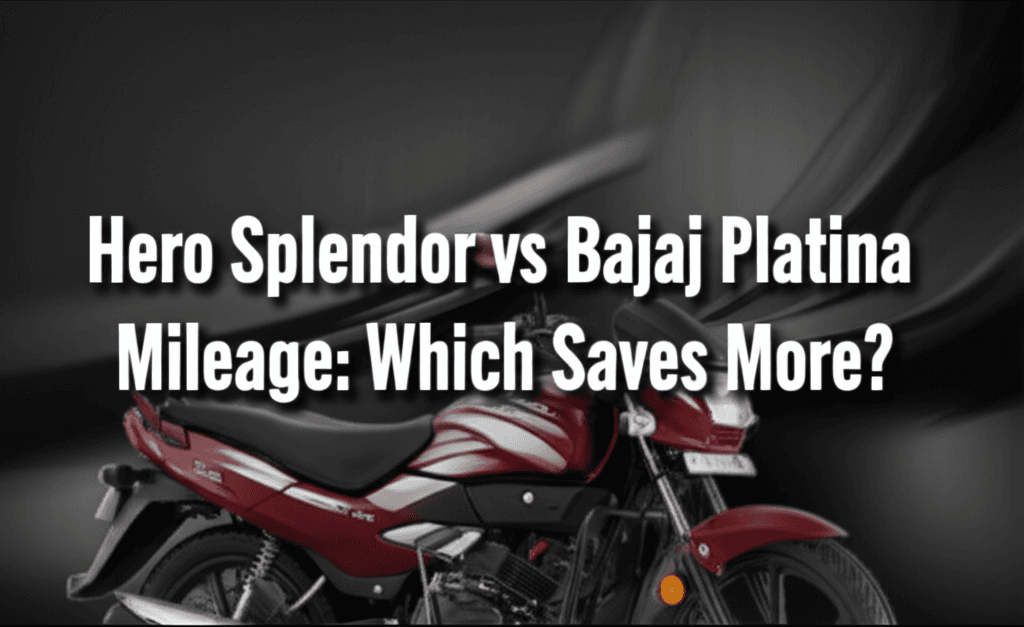Introduction
If you’re choosing between two of India’s most popular commuter motorcycles—the Hero Splendor and the Bajaj Platina—chances are your top priority is mileage. These bikes are built for daily riders who demand low running costs, easy maintenance, and dependable performance in city traffic. But when it comes to pure fuel efficiency, which one truly saves more in the long run? This comprehensive comparison dives deep into real-world mileage, engine performance, ownership costs, ride comfort, and long-term reliability. You’ll also find practical tips to improve fuel economy, along with a cost calculator example to estimate annual savings. By the end, you’ll know exactly which bike aligns best with your usage, budget, and riding style.
Overview: Why Mileage Matters for Indian Commuters
For most Indian buyers, fuel efficiency isn’t just a specification—it’s a daily budgeting tool. With fluctuating fuel prices and increasing traffic, every kilometer per liter (kmpl) counts. The Hero Splendor and Bajaj Platina have both built reputations as mileage champions. They typically offer 60–80+ kmpl in real-world conditions, depending on the variant and riding style. But there are subtle differences that can impact the total cost over time.
Key points shaping real-world mileage outcomes include:
- Engine tuning: Commuter-focused torque delivery can enhance efficiency in stop-go traffic.
- Weight and aerodynamics: Lighter bikes often sip less fuel in cities.
- Transmission: Gear ratios impact cruising efficiency and city drivability.
- Tyres and rolling resistance: Low-resistance tyres can add 2–3 kmpl in some cases.
- Riding habits: Smooth throttle control and timely upshifts are crucial.
Below, we compare the Splendor and Platina using the latest popular variants available in the market such as the Hero Splendor Plus and Bajaj Platina 100/110. Availability and specs can vary slightly by region and model year, so use the details here as a guide and always verify locally when purchasing.
Specs and Mileage Comparison
Engine and Performance
Both manufacturers have optimized their commuter engines for fuel efficiency and durability. The Hero Splendor typically uses a 97.2 cc or 100 cc-class engine in its Splendor Plus models, while Bajaj offers the Platina in 100 cc and 110 cc options. While displacement alone doesn’t determine mileage, overall tuning, compression ratios, and fuel delivery systems play a major role.
| Parameter | Hero Splendor Plus | Bajaj Platina 100/110 |
|---|---|---|
| Engine | ~97.2 cc, fuel-injected, air-cooled | ~102 cc (Platina 100) or 115 cc (Platina 110), fuel-injected, air-cooled |
| Power Output | ~7.9–8 PS (varies by model year) | ~7.9 PS (Platina 100) / ~8.6 PS (Platina 110) |
| Torque | ~8–8.1 Nm | ~8.3–9.8 Nm (higher on 110) |
| Kerb Weight | ~109–112 kg | ~117–122 kg (110 is typically heavier) |
| Transmission | 4-speed | 4/5-speed (varies by variant) |
| Claimed Mileage | Up to ~80–90 kmpl (ideal conditions) | Up to ~75–90 kmpl (varies by 100 vs 110 and conditions) |
| Real-World City Mileage | ~60–75 kmpl | ~60–80 kmpl (Platina 100 often edges ahead in city) |
| Highway Mileage | ~70–80 kmpl at steady 45–55 km/h | ~70–85 kmpl at steady 45–55 km/h (100 cc) |
Takeaway: The Platina 100 is often marginally more efficient in city riding thanks to its relaxed tuning and comfortable ergonomics that encourage smoother riding. The Splendor is extremely consistent across city and light highway use, with legendary reliability and predictable fuel economy.
Fuel System and Efficiency Features
- Fuel Injection (FI): Both bikes now feature FI systems that optimize cold starts, throttle response, and mileage.
- i3S/Start-Stop Tech (Splendor variants): Hero’s idle stop-start system helps in traffic by shutting off the engine at red lights and restarting with a clutch pull, saving fuel in cities.
- Low Rolling Resistance Tyres: Bajaj’s Platina often markets comfort and efficiency together; tyre selections and spring-in-spring suspension tuning can indirectly support better mileage.
Real-World Mileage: City vs Highway
City Mileage
In dense traffic with frequent braking and idling, real-world mileage often drops from claimed figures. Owners commonly report:
- Hero Splendor: ~60–70 kmpl in urban conditions with start-stop riding.
- Bajaj Platina 100: ~65–75 kmpl, sometimes touching ~80 kmpl with careful throttle use.
Why does the Platina sometimes edge ahead? Slightly taller gearing, plush ride comfort, and relaxed torque delivery make it easier to maintain lower revs. However, the difference is typically 5 kmpl or less for most riders.
Highway Mileage
At steady speeds of 45–55 km/h on state highways or ring roads:
- Hero Splendor: ~70–80 kmpl is achievable with light throttle and proper tyre pressure.
- Bajaj Platina 100: ~70–85 kmpl is possible in similar conditions, especially with a light rider and minimal luggage.
Note: Speeds above 60–65 km/h reduce mileage on both bikes due to increased aerodynamic drag and higher rpms.
Rider Weight and Load Impact
Additional load (pillion + luggage) impacts both bikes similarly. Expect a reduction of 3–8 kmpl depending on terrain and aggressive acceleration. Maintaining correct tyre pressure is critical when carrying a pillion.
Total Cost of Ownership: Which Saves More Over Time?
While mileage is critical, total ownership cost also includes insurance, service, parts, depreciation, and resale. Both Splendor and Platina rank high on affordability, but their strengths differ.
Fuel Cost Estimation
Let’s consider a typical commuter riding 1,000 km per month, fuel price of ₹105/liter (example), and real-world mileage of 65 kmpl (Splendor) vs 70 kmpl (Platina 100).
| Metric | Hero Splendor | Bajaj Platina 100 |
|---|---|---|
| Kilometers/month | 1,000 | 1,000 |
| Real-World Mileage | 65 kmpl | 70 kmpl |
| Fuel Used (L/month) | ~15.38 L | ~14.29 L |
| Fuel Cost (₹/month) | ~₹1,615 | ~₹1,500 |
| Annual Fuel Cost | ~₹19,380 | ~₹18,000 |
| Annual Savings vs Other | – | ~₹1,380 saved |
Result: In this scenario, the Platina 100 saves around ₹1,000–₹1,500 per year on fuel. Your actual savings depend on your riding style, traffic density, tyre pressure, and service quality.
Service, Spare Parts, and Reliability
- Hero Splendor: Known for legendary reliability, massive service network, and abundant spare parts. Routine service costs are low and predictable.
- Bajaj Platina: Also widely supported; Bajaj’s parts are competitively priced. The Platina’s comfort-oriented suspension might require periodic checks but doesn’t significantly raise costs when maintained properly.
Over 5–7 years, both bikes remain economical. The Splendor may retain slightly better resale value thanks to brand perception and widespread demand in the used market.
Ride Comfort, Features, and Daily Usability
Ergonomics and Suspension
- Platina’s USP: The Platina is widely praised for its Comfortec-oriented suspension and seat cushioning. Daily riders covering longer city commutes often prefer this setup as it reduces fatigue and encourages smoother riding—which indirectly improves fuel efficiency.
- Splendor’s Stability: The Splendor offers a neutral, upright riding posture with predictable handling. While not as plush as the Platina in some variants, it excels in agility and lightness, making quick urban maneuvers effortless.
Braking and Safety
Both provide adequate braking for city speeds; some variants offer front disc brakes. Choose based on your route: if you frequently ride on crowded roads with abrupt stops, a disc option might offer extra confidence without hurting mileage much.
Features That Affect Mileage
- Start-Stop Systems (Select Splendor variants): Can save fuel at signals.
- Tyre Choice: Low rolling resistance tyres can improve mileage by 2–3 kmpl but may change grip feedback.
- Chain Maintenance: A well-lubed chain reduces drivetrain losses.
Who Should Choose Which? Practical Scenarios
Best for Maximum City Mileage
Bajaj Platina 100 tends to edge out the Splendor in dense urban conditions by a small margin, especially for riders who value a plusher ride that encourages smooth throttle inputs. If your commute involves uneven roads, potholes, and long saddle hours, the Platina’s comfort package can be a real advantage.
Best for All-Round Reliability and Resale
Hero Splendor remains a top pick for buyers who prioritize simplicity, proven reliability, abundant spares, and strong resale value. Even if it’s 1–3 kmpl behind in certain city scenarios, it often makes up for it in maintenance predictability and used-bike demand.
If You Split City and Highway Rides
Both bikes perform well on highways at conservative speeds. Choose based on your comfort preference and local service experience. If your route is smoother and you like a light, nimble feel, the Splendor is excellent. If you crave extra seat and suspension comfort, the Platina is compelling.
How to Maximize Mileage on Either Bike
Actionable Tips
- Maintain Tyre Pressure: Check weekly. Under-inflation can reduce mileage by 5–10%.
- Use Steady Throttle: Avoid sudden acceleration. Shift up early around 3,000–4,000 rpm.
- Service on Schedule: Clean air filter, correct engine oil grade, and chain lubrication dramatically improve efficiency.
- Travel Light: Remove unnecessary luggage and avoid heavy accessories that add drag.
- Plan Your Route: Fewer stops and smoother roads equal better mileage.
- Use Start-Stop Feature (if equipped): Maximize savings at long signals.
Fuel Quality and Riding Conditions
Stick to trusted fuel stations. Poor fuel quality can cause knocking and lower mileage. In monsoon conditions, ensure tyres are in good health to maintain momentum and prevent wasteful braking/acceleration cycles.
Real-World Examples and Use Cases
Example 1: Urban Office Commuter (15–20 km/day)
An office-goer traveling 18 km daily in a Tier-1 city faces heavy traffic and frequent signals. With attentive riding:
- Platina 100: ~68–75 kmpl
- Splendor: ~62–70 kmpl
Over a year (~5,400–6,000 km), the Platina may save ~₹600–₹1,500 in fuel depending on prices and throttle discipline.
Example 2: Mixed Commute (City + Ring Road)
A rider covering 30 km/day with 60% city and 40% ring road at 50–55 km/h can expect:
- Platina 100: ~70–80 kmpl
- Splendor: ~68–78 kmpl
The difference narrows, making both equally viable. Choose based on comfort vs nimble feel.
Example 3: Delivery Rider with Pillion/Load
Frequent start-stop cycles and cargo add weight, reducing efficiency:
- Platina 110: May offer better torque for load, yielding smoother rides around 60–70 kmpl.
- Splendor: ~58–68 kmpl depending on load and maintenance.
Pros and Cons Summary
Bike Pros Cons Hero Splendor
Exceptional reliability and vast service network Consistent real-world mileage High resale value Easy parts availability and low maintenance
Ride not as plush as Platina on rough roads May be slightly behind Platina 100 in dense urban mileage Bajaj Platina 100/110
Often edges ahead in city mileage Class-leading comfort for daily commutes Relaxed engine behavior suits stop-go traffic
110 cc variants may return slightly lower mileage vs 100 cc Resale may trail Splendor slightly in some markets

